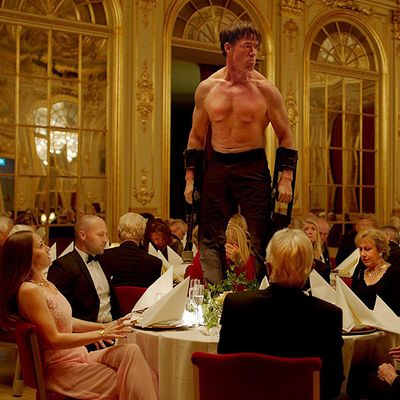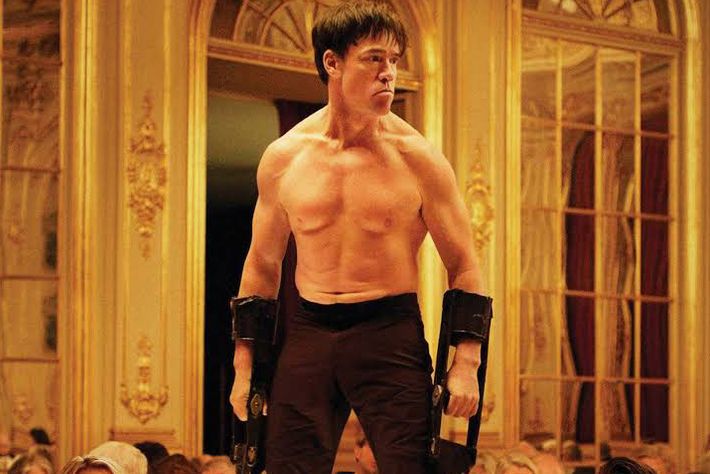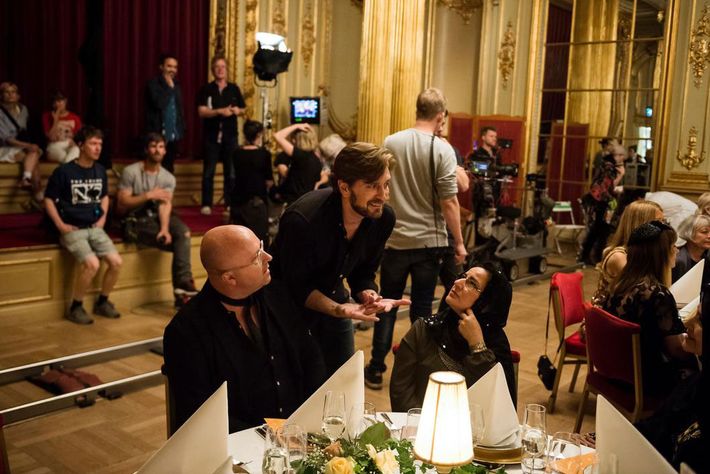
Spoilers for The Square ahead.
There is an insane — call it “bonkers,” or “fucking nuts” — 12-minute scene in The Square wherein a shirtless man (Terry Notary) doing a performance as a chimpanzee terrorizes a black-tie museum gala in Stockholm. Whooping and jumping on tables, he goes from kind of amusing to absolutely unacceptable to even worse, and all before these wealthy Swedes have even had their appetizers. Guaranteed, you have never seen a scene like this. It is a scene of legends, a scene so indelible it’s on the movie’s poster and in all its trailers, even though it’s a mere fraction of director Ruben Östlund’s two-and-a-half-hour opus.

Östlund loves nothing more than revealing the base animal instincts that flood to the surface when societal conventions break down. His previous (amazing) film, 2014’s Force Majeure, is about a father and husband who runs off when it looks like an avalanche is coming straight for his family, and then has to continue on a five-day ski vacation with them after everything turns out okay. It is so deliciously awkward. The Square centers on your new Danish crush, Claes Bang, as a museum curator who starts losing all sense of civility in the anger and revenge plots that well up after his wallet and phone get stolen. And that pivotal “monkey performance” scene is, in essence, Östlund’s thesis about dangers of herd mentality, and how easy it is to ignore other’s pain when you’re focused on self-preservation. (Sounds a lot like Hollywood, at least a couple of weeks ago.)
The Square, which won the Palme d’Or at this year’s Cannes Film Festival, has finally come out in the States. Vulture spoke with Östlund and Notary — who’s been a motion-capture actor and movement coach for the Planet of the Apes movies, plus played Kong in Kong: Skull Island — about how they made the most unnerving, uncomfortable scene of the year.
Inspiration.
I asked Östlund why he wrote this scene and he replied, cryptically, “You can ask yourself why you do anything.” Though he sort of explained that his mission is to make movies full of interesting, stand-alone scenes that highlight human behavior. “I have not been that interested in storytelling,” said Östlund. “I never want to have any in-between scenes that are only there to tell the plot. If I have these scenes I think I’ve failed a little bit as a director.”
Ideas started flooding in once he devised the voice-over that begins the gala. Guests sit down, the room darkens, and a warning issues from the speakers: “Welcome to the jungle. Soon you will be confronted by a wild animal.” The white-haired donors whisper among themselves excitedly. What kind of treat is in store?
The voice warns that the animal is trained to sense weakness and fear, so the best defense is to stay very still and hope for the misfortune of others. “It’s about the bystander effect,” said Östlund. “The reason we don’t have the ability to take responsibility in situations like that is because we are herd animals and we get scared, and when we get scared we get paralyzed. And we’re thinking, don’t take me, don’t take me, take someone else.”
Östlund at first envisioned a “wild animal” artist inspired by the late punk rocker GG Allin, who was once arrested for defecating onstage. “I’ve never seen anyone that is that anarchistic,” said Östlund. (Even Kurt Cobain was “too afraid” to go to one of his concerts.) Then one day, the director typed “actor imitating monkey” into YouTube and came across a Notary demo for Planet of the Apes, using mechanical arm extensions he’d developed himself — kind of like prosthetics, or crutches for the hand — showing the different ways orangutans, chimps, and gorillas move. “It was fantastic to see! It was such an impressive performance that he did,” said Östlund, who loves monkeys so much he gave Elisabeth Moss’s reporter character one as a roommate in The Square. As Östlund said in Cannes, “Anything can happen in a movie when suddenly a monkey appears in an apartment … Everything should have a monkey in it.”
Notary had never heard of Östlund before he called to offer him the part of a monkey-imitating artist named Oleg, but he did know and love Force Majeure. They switched to video chat and, Notary said, “I loved the guy from the second I met him. Ruben said, ‘It’s a central, pivotal scene. I want you to just terrorize this group of partygoers.’ And I thought, Ooh, that sounds fun. I’m into it.”
Rehearsal, naked.
The scene took four days to shoot, the first of which was a blocking rehearsal in the ballroom, minus the 300 extras who’d be playing wealthy art donors. “The structure of the scene is quite simple,” said Östlund. “He should walk into the room, be a little scared at first, then start to be a little playful, and then chase away the alpha male” — Dominic West’s character, Julian, a big-shot American artist. “And then when they have chased away the alpha male, then it’s time for reproduction.” (More on that very upsetting turn of events in a minute.)
Notary was doing exactly what he’d do in a movie like Apes, just without his motion-capture suit. The only enhancements to his appearance were the arm extensions (for the first time in a movie, not CGI-ed out) and that yellowed, rather savage-looking underbite. As soon as the teeth were in, he said, “It was like Oleg was there and Terry was gone. Only when the teeth came out would I actually allow myself to talk to people and say, ‘Are you okay? Is it okay if I move you around like that? Can I push you around a little harder on the next one?’”
Oh, and Östlund had originally thought Notary would be doing the scene naked, so that’s how they rehearsed it, plus shot an unnerving video installation of him grunting like an ape straight into camera that appears as backdrop in one of Bang’s scenes. (It’s not a full body shot, so you just can’t see that aspect on camera). “And it was really interesting because I was like, I’m really scared about being naked, but why? Why am I scared about being naked? I have to overcome this.” By the end of the day, even though they decided to give his character pants, Notary was glad he’d done it. “Then it was like, Well, anything can happen with this character now. I’ve been completely naked in front of this group of people,” he said.
Just add 300 extras.
The extras that Östlund added on the first day of shooting were actual Swedish artists and curators. “I was really trying to find the right kind of audience for that room,” he said. “People who are in the art scene, you can tell that they been trained for many, many years on how they should look, in every little detail.” In other words, he wanted an audience that could be believably blasé about a monkey-man rampaging around them.
None of the extras knew exactly what they were getting into. Östlund simply played the voice-over on a speaker and had Notary lumber in and do his thing. The way Östlund works is to extensively workshop every scene, and then, once he’s figured out how it should go, shoot it 60 to 70 times. Needless to say, the element of surprise didn’t last, but Östlund asked the extras to rely on their emotional memory, and Notary tried to change things up every take. “It’s actually a very precise structure of the scene,” said Östlund. “I get that question often, if people knew what he was supposed to do. And they did, but I think they felt scared anyway.”
Notary’s strategy, indeed, was to toy with the most frightened people in the room. Anytime someone talked to him between takes and asked to be picked, he said, “I was like, Mmm-hmmm. Definitely not going to pick that person.” But even the most reluctant extras had signed off on getting rough treatment or being thrown out of their chairs. Östlund waited until the end of the last day to tell Notary who they actually were. “He was like, ‘Do you know who this person is that you’ve been throwing water on? That’s a billionaire donor. They’re the biggest donors in the art world of Sweden.’ I was like, ‘Oh my god!’ It was really smart of him not to tell me any of that until after. Because I thought they were making 120 bucks a day being extras, happy to be there. But they just really wanted to be a part of this film. And they were fine with the water-throwing!”
Getting rid of the alpha.
To take over the room, Notary knew he first had to win over the hearts of the herd. He did that by playfully flirting with a blonde (touching her hair, hooting with delight to the crowd) and showing off his arm extensions, as if to say, “Just a performance, folks!” He was drawing from a charisma he saw while studying chimps at the L.A. zoo for Apes. The key to a great ape imitation, he realized, is to worry less about the right movements than about capturing a childlike lack of emotional filtering. “It’s about removing the social conditions, and not being afraid to be open, vulnerable,” he said. “They don’t repress or suppress feeling. They breathe it in and out like air.”
Notary’s Oleg is even kind of charming when he’s being aggressive toward Dominic West’s Julian. He slams his arms to the ground and hoots in his face, but he also sticks his finger in Julian’s ear and places a napkin on Julian’s head like a hat. Julian plays along and the room roars with laughter. It’s only when Julian signals to Oleg that he’s done, by turning away to drink some water, that the mood shifts, and Oleg knocks the glass out of his hand. Soon, he’s backing Julian against a table filled with horrified women, and chasing him out of the room. West’s character is essentially the guest of honor and no one steps in to defend him.
Notary and West never discussed what they were going to do, just the broad beats of the scene. And Östlund, too, was mesmerized by the things Notary came up with. “So many of those body movements were things that only he could do,” said Östlund. “Like when he slaps the glass out of Dominic West’s hand, there’s some strange sound that he does, almost like laughing. I can look at these moments over and over again. I think he does it in such a beautiful way.”
“It’s going further? Are you kidding me?”
Bang came up with the idea that he’d stand up, as the museum’s chief curator, and ask for a round of applause for Oleg as a way of stopping the performance after West runs off. “I think that’s a genius move,” said Östlund. “Claes added it and I like that part of the scene so much.”
Oleg’s response, of course, is a very definitive ape growl. “He’s like, ‘Oh, I’m not done yet. We’re just getting started now. This the energy that I want the room to have,’” said Notary. “Ruben likes to push you to where you’re like, ‘Oh my god, I can’t take it anymore.’ And then it starts over again, and you’re like, ‘It’s going further? Are you kidding me?’ And that’s what I like about him. Even as a director he does that for you as an actor. He’ll just keep pushing and keep saying, ‘Go more! Go more! Keep going!’’’
Notary played Oleg as an angry artist out to destroy our complacency by stripping away the social conditions that our animal instincts in check. “He sees humanity as becoming this weak separate thing from the real base humans that we are, which were these survival hunter-gatherers who knew that if you were weak you’d die,” said Notary. “He wanted to come in with this force and scare them so that, for just one instant, they could feel what it feels to actually be alive again.” (So, Westworld, if Ed Harris were a chimp.)

Establishing dominance.
The next step after chasing away the alpha is to become the alpha. Bang claps, Notary resists, and at that moment, a cell phone rings, prompting Notary to run across the room to rip the headscarf off the woman whose phone it is. A man stands up to defend her and there’s a struggle that we can’t quite see because it takes place in a shot from across the room, but Notary assured me that he was barefoot and the man was kicking him with dress shoes and it was not very pleasant.
“We did that take four for five times on the the floor and that’s when my right pinkie toe got broken,” he said. “It got raked! Like so, so painfully raked! I was like, ‘Maybe on the next one, if you could not rake up my feet and kick on the floor …’ But everyone was so in the moment that it was like, ‘Oh well, it’s going to happen every time.’ It was really good, because the pain was so real.”
Now it’s time for reproduction.
The scariest part for Östlund as a director was when, after the toe-breaking cell phone fight, Notary had to gallop on all fours across the ballroom and jump up onto a table covered in glassware — still barefoot. “We didn’t do that part of the scene that many takes because it was quite dangerous for him and I was super scared that he would hurt himself,” said Östlund. It wasn’t unjustified fear; Notary’s feet were definitely bleeding, according to Notary. “When Terry is going for the scene, he’s willing to go so far,” said Östlund. “After shooting, me and Dominic and Terry and Claes went and had a dinner, and Dominic was like, ‘This is the best performance that I have ever seen.’ I think that everybody that was in that room was like, ‘Oh my god, this is acting. This is acting.’”
The final sequence begins when, from his tabletop perch, Notary spies a beautiful redhead (Madeleine Barwén Trollvik) sitting in front of him. Grunting with pleasure, he kneels down to tousle and smell her hair. She laughs nervously and calls out to a male companion for help. He stares at the floor. It’s a mini-reprise of Force Majeure. “Well, I love that situation of course,” Östlund said. “It’s a little similar to the avalanche situation, where afterwards they will have a problem.”
Then, suddenly, Notary jumps off the table and drags the redhead along the floor as she screams to a corner of the ballroom, in front of everyone, where he tries to mount her. “She’s a stuntwoman,” Östlund assured me. “We didn’t put up an extra to do this thing!” Notary was so scared of hurting her that he asked if they could rig up some sort of rope that he’d pull instead of her hair. “And she was like, ‘Let’s pull my hair for real. I’ll grab your hands and it’ll look good. Let’s get it in a oner,’” he said. “So I turned it into part of the choreography that I’d gather up as much hair in a hand as I could before I pulled her off that chair. She was tough! And I think it looked real, because it was real.”
An excruciating ten seconds of struggle goes on — two minutes since he started targeting her — before a lone older gentleman runs over to shove him off her, then a younger guy, then every man in the room. Ostlund shoots upward from Notary’s POV so all we can see are these men’s rage-filled faces and their pummeling fists.
Östlund made The Square before the fall of Weinstein, Ailes, O’Reilly, etc., but said he believes the scene is “a good metaphor for that.” In the end, it may be more about Twitter culture. His inspiration for the ending was a TED Talk he found on YouTube (Östlund loves YouTube almost as much as he loves monkeys), about how movements are started not by leaders, but by the first couple of people who follow them and lower the risk of doing so. The monkey-man scene is a kind of movement in that sense. One man enters the room with his base animal instincts unchecked, and soon everyone around him has turned into beasts. “These people that in the beginning were sitting in tuxedos and eating their nice, fancy dinner, I wanted them to be uncivilized animals in the end,” said Östlund. “I think that the most uncivilized thing about our time is the collective rage against individuals that are acting uncivilized. Isn’t that the scary thing about us?”




